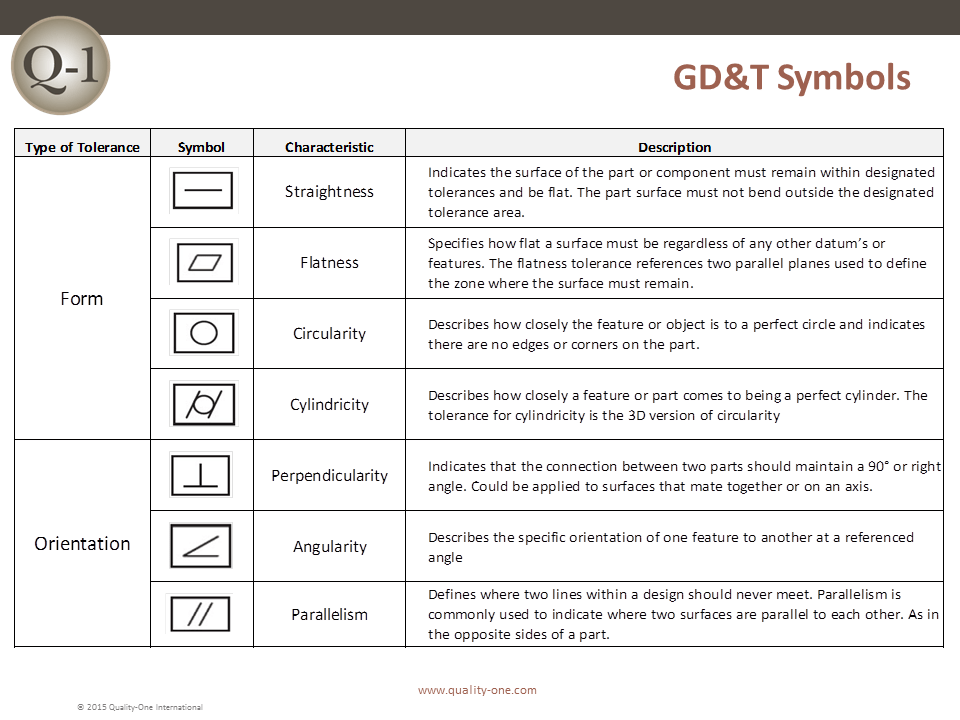GD&T
– Geometric Dimensioning and Tolerancing –

Introduction to Geometric Dimensioning & Tolerancing (GD&T)
In manufacturing, quality is paramount, costs must be controlled and the processes must minimize waste and use resources wisely. To reduce cost many component parts are currently being sourced from suppliers all over the world. The need for accuracy in part design and manufacture is greater now than ever before. It is imperative that the design intent and functionality of the part be clearly communicated between the design engineer and the manufacturing plant. Geometric Dimensioning and Tolerancing (GD&T) is a precise language of engineering symbols that clearly communicate the design intent of the part. The result is an improvement in communication and part quality. The GD&T methodology is currently used in Automotive, Heavy Equipment, Aviation and several other industries. The standard used in the United States for defining GD&T methodology is ASME Y14.5-2009.
GD&T History
The origin of GD&T has been credited to a man named Stanley Parker, who in 1938 developed the concept of position or “true position” as it is referred to today. Mr. Parker, by all accounts, worked in a munitions facility in Great Britain. During his time there he encountered parts for torpedoes that were rejected when inspected using traditional tolerances. However, he found that many were functional parts and were being sent to production even though they were technically out of specification tolerance. Upon further investigation, he determined that the standard X-Y coordinate tolerances resulted in a square tolerance zone. Some of the dimensions of the working parts fell slightly outside of this zone but were within a circle that encompassed the square’s corners. He surmised that if the corners were in spec, in most cases the parts that fell within that circular zone resulting from the application of the same tolerance were just as functional. Mr. Parker would later publish a book in 1956 entitled “Drawings and Dimensions”. Mr. Parker’s determination of position (or true position) has since grown to include other concepts including flatness, profile, runout, roundness and much more. The concept of GD&T was adopted by the military in the 1950s and is now in use in multiple industries around the world.
What is Geometric Dimensioning & Tolerancing (GD&T)
Geometric Dimensioning and Tolerancing (GD&T) is a language of symbols used to describe a part’s nominal geometry and the allowable tolerance for variation. When applied properly the design engineer can concisely define a features location, size, shape and orientation on the part. GD&T is intended as an addition to the coordinate dimensioning system, not as a complete replacement. The GD&T methodology takes into consideration the function of a part and how that part functions with related parts. Therefore, for proper application of GD&T you must have a thorough understanding of the function of the part within an assembly. GD&T has established standards used throughout the world. The proper application of GD&T is defined within an American Society of Mechanical Engineers (ASME) standard used primarily in the United States and within an International Organization for Standardization (ISO) standard used by many European countries.
Why Implement Geometric Dimensioning & Tolerancing (GD&T)
When you first examine the GD&T system and the many symbols used for defining part dimensions and tolerances it may seem overwhelming. Through application of GD&T in your designs the symbolic language soon becomes familiar. When the GD&T system is used properly it reduces the amount of notes, dimensions and tolerances required on a drawing. In addition, by establishing datums, GD&T provides a precise method for describing a reference coordinate system that can be used during the manufacturing and inspection processes. Through application of the GD&T standardized language of symbols you can clearly communicate the design intent to the manufacturer of the part. The application of Geometric Dimensioning and Tolerancing (GD&T) methodology has proven to reduce cost and improve quality, reliability and safety. By implementing the GD&T tools and methodology your business will benefit through the reduction of manufacturing issues, rework and scrap. In addition, when you take the function of the part into consideration, GD&T allows for the application of a greater tolerance range, reducing the quantity of functional parts being rejected. By reducing rejected parts you thereby increase your first time yield resulting in improved efficiency.
How to Implement Geometric Dimensioning & Tolerancing (GD&T)
There is a very large amount of information available describing how to apply Geometric Dimensioning and Tolerancing (GD&T) to your designs. Within this section we will explore some fundamental rules, basic concepts and symbols contained within the GD&T standards. The fundamental rules of GD&T are the foundation on which the system is built. The rules require that every dimension have a tolerance applied except for reference dimensions or min / max values. The rules also require that the dimensions and tolerances on the drawing be fully defined to assure that the characteristics of each feature are fully understood. In addition, all necessary dimensions of the end product must be defined and the use of reference dimensions kept to a minimum. The dimensions must also be selected and arranged according to the function of the part and its relationship with mating parts. Through adherence to the fundamental rules of GD&T the designer is able to clearly relay the design intent while minimizing the chance of it being misinterpreted.
Datum and the Datum Reference Frame
A datum can be described as a theoretical exact plane, point or axis location from where the remaining features of a part are referenced from. Dimensional tolerances are referenced to the datums.
The concept of a Datum Reference Frame (DRF) is one of the most important within GD&T. The DRF concept describes the creation of three mutually perpendicular and theoretically perfect planes. The three planes are required for manufacturing and inspecting a part to the drawing, and detailed below:
- The primary datum is established with a minimum three point contact of the first feature of the part
- The secondary datum is established with a minimum of 2 contact points of the second feature contacted
- The tertiary datum is established by a minimum of 1 point of contact
Through the process of designating three mutually perpendicular datum planes you have established the Datum Reference Frame (DRF).
The Feature Control Frame
The geometric tolerance for an individual part feature is indicated within the Feature Control Frame, which is divided into separate compartments. In the first compartment you place the symbol for the geometric characteristic you are defining, such as true position, profile or runout. The second compartment contains the tolerance call-out. In some cases the tolerance may be preceded by a diameter symbol. The datum planes should be placed in the remaining compartments. Always remember to list the datum planes in the proper sequence (primary datum first).
True Position and Position Tolerance
True Position or Position, as it is referred to in the ASME standard, is one of the most widely used symbols in GD&T. The True Position represents the nominal value or the exact coordinate location of a feature. Any feature on a part having a True Position of 0.000 would be located exactly where it is should be. A True Position of 0.030 means the part feature or designated point is 0.030 off from where it is should be. Position can be defined as the total allowable variation a feature can have from its nominal value or its “true position”. Position tolerance can be used to control the location, orientation or axis offset of a part feature or axis. Position tolerance is commonly applied to features critical to assembly with the mating part like bolt holes or slots.
Regardless of Feature Size (RFS)
The definitions of all the GD&T symbols are by default, stated as Regardless of Feature Size (RFS). RFS basically means that all GD&T callouts are controlled independent of the size of the part. This eliminates any potential additional tolerance, allowing the designer to more accurately control tolerances. RFS requires no callout on the drawing. RFS can be overridden if the Maximum Material Condition (MMC) or Least Material Condition (LMC) are called out on the drawing specifically to eliminate the RFS default.
Language of Symbols
In order to properly apply Geometric Dimensioning and Tolerancing (GD&T) you must become familiar with the language of symbols. There are various symbols and types of applied tolerance used in GD&T.
When first reviewed, this language of symbols may seem quite overwhelming. But just like any tool the more you use it the easier it becomes. When GD&T is fully utilized it will improve communication from the designer all the way to the shop floor. By using the GD&T established standards of detailing your drawings, the design intent can be fully understood by suppliers all over the world. With GD&T you can develop clearly defined designs, taking the function of the part into consideration and allowing for more accurate tolerancing. The quality of your parts will increase and the scrap rate will decrease resulting in a win/win situation for you and your suppliers. For additional information regarding GD&T, contact one of our experienced professionals at Quality-One.
Learn More About Geometric Dimensioning & Tolerancing (GD&T)
Quality-One offers Quality and Reliability Support for Product and Process Development through Consulting, Training and Project Support. Quality-One provides Knowledge, Guidance and Direction in Quality and Reliability activities, tailored to your unique wants, needs and desires. Let us help you Discover the Value of GD&T Consulting, GD&T Training or GD&T Project Support.

